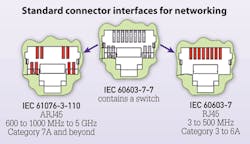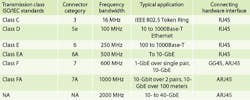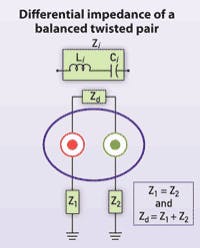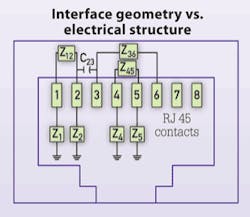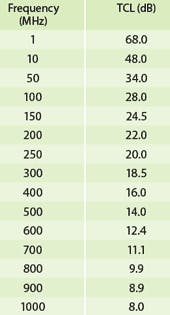April, 2012 Issue of Cabling Installation & Maintenance Magazine
Differential- to common-mode conversion, transverse conversion loss and twisted-pair connector interfaces may be significant factors in transmission beyond 500 MHz.
By Yakov Belopolsky and Richard Marowsky, Bel Stewart Connector
Close to one billion users are connected to the Internet today. Many of them are connected through copper-wire channels, either leading to a final user or as part of the infrastructure. The Internet is built upon the standardized Ethernet protocols described in the 802.3 standards put forth by the Institute of Electrical and Electronics Engineers (IEEE; www.ieee.org). The move toward 40- and 100-Gigabit Ethernet requires better and faster connectivity and lower noise within the transmission system.
The Ethernet signals use what is known as differential mode transmission. Each differential channel consists of two conductors, and requires balance within the transmitter or receiving pair. Or, in electrical terms, the characteristic impedance of each conductor within the channel shall be equal—typically 50 Ohm. If the balance is violated, the result is a transformation of a portion of the original signal energy into parasitic common-mode noise. This differential- to common-mode conversion (DCMC) worsens the transmission by reducing the signal strength and adding to the level of noise.
This article will discuss the relationship between DCMC and the interfaces used for twisted-pair copper cabling systems. The discussion will be limited to the application spectra above 500 MHz, for which there are no current Ethernet protocol specifications, but is a frequency range in which research and testing are taking place.
Interfaces and connectors
The interface between a network appliance and the premises wiring is an interface between the building cabling infrastructure and equipment such as a switch or computer. For the user it is simply a port into which a patch cord is plugged. In reality, the engineering behind the simple patch-cord plug-in is far from simple. In fact, there are two networking interfaces, which have rather complex electrical and mechanical characteristics, where the mechanical structures directly impact the transmission performance. The networking-equipment connectors are not covered by premises-wiring standards.
The first interface is a connector, most often an RJ45 or ARJ45 (augmented RJ45). At the network-appliance side it is usually a receptacle (a jack). At the premises wiring side it is a plug. This interface is the interruption and disturbance of the twisted-pair media.
The second interface is a transformer that provides a safety barrier between cables and a networking appliance. Often transformers, other magnetic elements and other signal-conditioning components are incorporated into the connectors. Such connectors are referred to as integrated connector modules (ICMs).
As a result, the connectors specified in TIA-568 series and ISO/IEC standards for premises wiring have the same name as network equipment connectors, but they look and function differently. What they do have in common are the interfaces.
The interface is subject to mechanical stresses and abuses. It is subject to electrical discharges due to connection and disconnection under the electrical load, particularly in Power over Ethernet (PoE) applications. Yet the interfaces must be inexpensive and therefore not complex; they must be robust and easy to use for millions of people.
The basic connector, illustrated in the figure on page 21 that shows three common connector interfaces, is a 12-contact, Category 7 connector that is described in ISO/IEC 60603-7-7. The dimensions of its openings and its contact positions were derived from the traditional RJ45 jack. The 8-contact RJ45 and ARJ45 connectors are its subsets. With an exception of the presence of bottom contacts, all the dimensions of the ARJ45 are identical to those of the RJ45.
The Category 7 connector has a mechanical switch inside of it that serves to redirect the signals from traditional split pairs, 3-6 and 4-5, to new pairs located on the opposite side of the cavity. A Category 7 jack can accept either Category 6A or lower RJ45 plugs, or Category 7 and 7A plugs. The same plug is used for Category 7 and Category 7A connectors. This plug has a keying feature that prevents it from mating with Category 5e, 6 and 6A jacks. A Category 7 and 7A plug has a protrusion in the front that activates a mechanical switch within the Category 7 connector. A patch cord can have a Category 6A plug on one side and a Category 7A plug on the other.
The Category 7A connector, ARJ45, does not have any split pairs. An alternative Category 7A connector that was not derived from the RJ45 interface is described in ISO 61076-3-114.
Compensation vs. isolation
The major difference between the RJ45 and ARJ45 connectors and interfaces is how the differential near-end crosstalk is attenuated. That issue was one of the primary reasons why the International Organization for Standardization (ISO; www.iso.org) decided to change to a new interface for applications above 500 MHz in the ISO/IEC standard 60603-7-7.
The RJ45 connectors, Categories 5e to 6A, use compensation to cancel the differential near-end crosstalk. The compensation is a method of purposefully creating the crosstalk in the near vicinity of the interface that is equal in amplitude, but opposite in phase, to the near-end crosstalk “native” to the interface. In practice, it calls for adding capacitive and some inductive elements, and creating complex structures within the connectors. The compensation in the RJ45 connectors is used in both shielded and unshielded designs.
The Category 7A connectors rely on isolation to attenuate the near-end crosstalk. Category 7A connectors are always shielded. What is known as a Faraday cage is built around each differential pair; this cage isolates the pairs from each other, thus reducing near-end crosstalk. The ARJ45 interface design allows the isolation to be extended through a plug and a receptacle.
An additional and valuable benefit of an isolation method design is a dramatic improvement in the transverse conversion loss (TCL) in comparison to lesser interfaces.
The measure of the balance and DCMC applicable to the interface is described in the connecting-hardware standards as the TCL, or Sdc11 as an S-parameter.
TCL (dB) = 20Log (Common Mode Voltage/Differential Mode Voltage) – measured at the same end
It is useful to keep in mind that TCL is the measure of the quality of the interface as a source of common mode. Both the TIA and ISO/IEC standard expressions yield the same values, as shown in the table on page 25.
Balanced twisted-pair environment
Outside the connector contacts proper, which form the mechanical interface, the regions directly adjacent to the interface are twisted pairs. On one side is a patch cord and on another side is a high-performance LAN transformer.
The differential pairs of the high-performance 10-Gbit Ethernet LAN transformer windings are twisted. In addition to reducing the inter-winding capacitance, which is always parasitic, the twisting directly improves the DCMC. Also, the highest-performing LAN magnetics (both chokes and transformers) tend to use a controlled media, such as ferrite, on all sides of the channels within the windings.
The impedance of a balanced twisted pair is derived from the impedance of two conductors. The differential impedance in this case does not have a resistive component and consists of the inductance and capacitance.
The prime source of TCL is change in the geometry defining the characteristic impedance on the interface. Compare the figures on page 23 entitled “Differential impedance of a balanced twisted pair” and “Interface geometry vs. electrical structure.” The interface-geometry figure is an electrical structure of the RJ45—one of the most popular connectors in the world—where differential pairs are defined as contacts 1-2, 3-6, 4-5, 7-8.
The positions of the contacts in the RJ45 interface are such that there is explicit imbalance. The pair 4-5 is intrinsically better balanced, as is pair 3-6, though their impedance is hard to match to each other. The intrapair balance of differential pairs 1-2 and 7-8 are affected by their positions, where contacts 2 and 7 capacitively couple to adjacent contacts, and Z1≠Z2. The result is a skew and the degradation of the TCL.
Other sources of imbalance also exist. All Category 6A connectors are supposed to meet minimum TCL requirements. Within the plug, the patch cord is changed from the twisted to the interface geometry. The balanced plug incorporates the design where at least a portion of the transmission channel within the plug is balanced or controlled. Technology, sometimes referred to as a wire guide filter, is used in which pairs are guided through the plug to mimic the balance of a twisted-pair cable.
Thus, within Category 6A connectivity there are subsets of balanced and unbalanced connectors. The Category 7A connectors maintain the balance and low TCL to the spectra well above 1000 MHz.
Negative effects of high TCL
The high TCL causes greater common-mode noise. The common-mode noise reduces the signal energy. Generally the common-mode signal has a different propagation velocity from the differential signal. It also has an arbitrary phase. Two common noise signals can form an effectively parasitic differential signal superimposed on the original useful transmission. The common noise causes electromagnetic interference (EMI) and jitter. As a contributor to the alien near-end crosstalk, it may cause bit errors. The shorter the channel length, the greater the negative effects of the TCL.
Reductions in TCL and corresponding DCMC translate to a lower noise, and potential increases in the useful channel length. The direct contribution of TCL to the channel length depends heavily upon the cable quality—specifically, the cable’s insertion loss. Though the experimental evaluation is still in progress, the estimated increase in length that comes with a 10-dB TCL reduction can be as high as 10 meters for 500-MHz applications.
The computer modeling we conducted in Bel Stewart Connector’s research-and-development facility used coaxial structures and established a theoretical limit for Sdc11 as 98 dB at 1000 MHz. The table above provides a comparison of the TCL values for balanced and unbalanced Category 6A connectors and Category 7A ARJ45 connectors. Numbers in the column “Unblanced RJ45” represent the TCL limit as opposed to actual data from unbalanced Category 6A connectors.
In summary, transverse conversion loss defines the interface as a source of differential- to common-mode conversion. The common-mode noise negatively affects network transmission. Internet traffic from 1-Gbit Ethernet to 10-Gbit Ethernet and, in particular, new 40-Gbit Ethernet systems should benefit from balanced Category 6A connectors. In the frequency spectra above 500 MHz, Category 7A connectors can provide improvement of more than 15 dB in comparison to Category 6A, and extend the channel bandwidth to 2000 MHz and above.
Yakov Belopolsky is manager of research-and-development and Richard Marowsky is principal electrical engineer with Bel Stewart Connector (www.belfuse.com/stewartconnector). If you have comments or questions about the technical detail provided in this article, please contact our editor. You can reach him via email at [email protected].
Past CIM Articles
